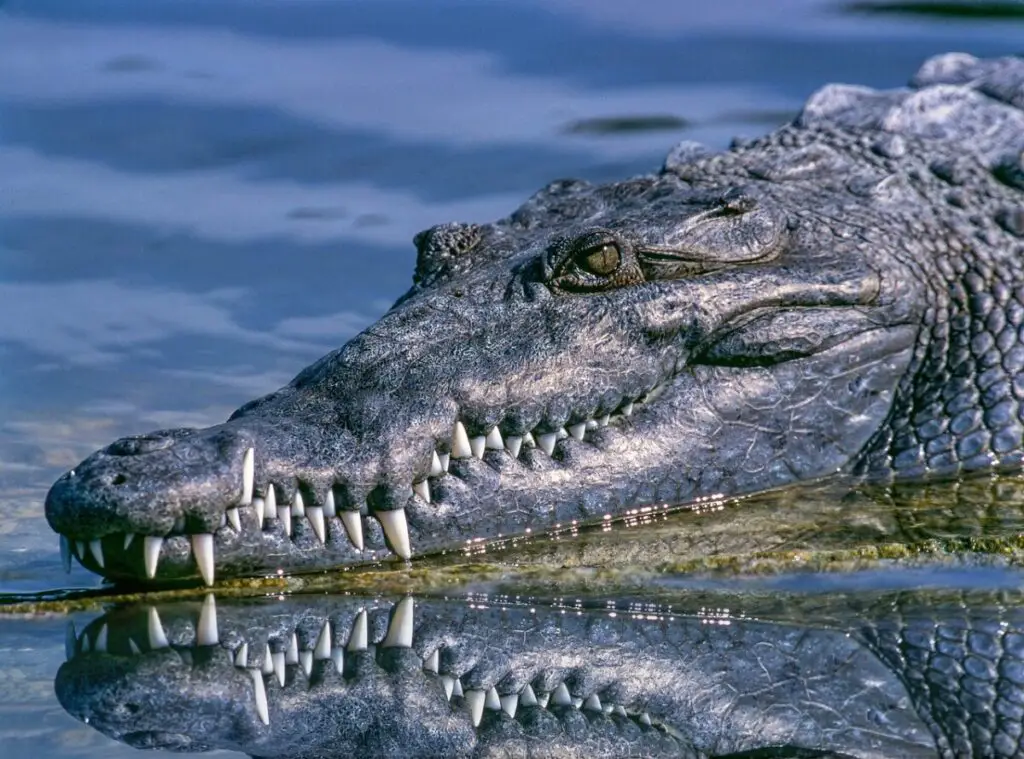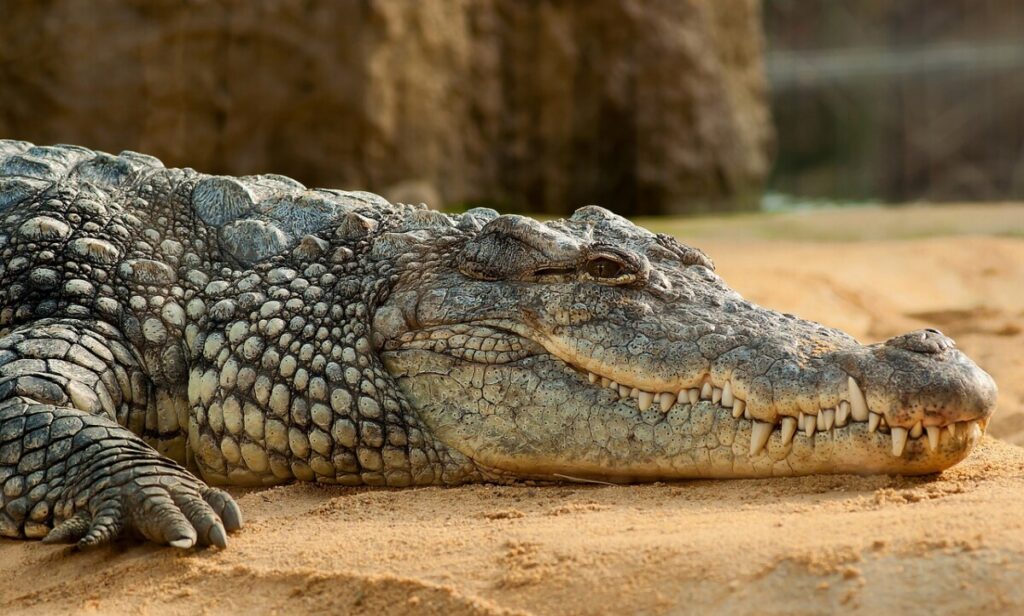Crocodiles have existed for over 250 million years, and are one of the most ancient species on earth. They occupy a variety of habitats in tropical and subtropical regions, from rivers to swamps to mangrove forests.
As an apex predator, crocodiles play an important role in their ecosystems by controlling populations of prey species such as fish and birds. Despite extensive research, there is still much that we do not know about these animals; this article will provide an overview of what is currently known about them.
Crocodiles are large reptiles belonging to the order Crocodilia which includes alligators, caimans, gharials and false gharials. Their long snouts give them a distinct appearance among other reptile groups and they can be identified by skin ridge patterns unique to each individual animal.
Depending on the species, crocodiles range in size from 2-7 metres (6-23 feet) in length with males typically being larger than females. The largest type of crocodilian is the saltwater crocodile with individuals reaching up to 7 metres (23 feet).
Crocodilians possess several physical adaptations suited for life both in water and land including webbed toes for swimming, powerful tails for propulsion through water, sharp teeth for catching prey and eyes located at the top of their head so they can see above the surface when submerged.
In addition to these impressive abilities, some types of crocodilians also display complex social behaviour such as forming hierarchies and cooperative hunting strategies. This article will explore further details regarding habitat preferences, conservation status, reproductive behaviour and more related to this fascinating group of animals.

Classification
Crocodiles are members of the reptilian order Crocodilia, which contains 23 living species and is divided into three families: Alligatoridae, Crocodylidae, and Gavialidae. Commonly referred to as crocodilians, these species are found in tropical regions throughout the world including Africa, Asia, Australia, and North America.
The taxonomy of crocodylia has been a matter of debate among scientists for centuries. Historically, this group was commonly classified by tooth shape or size; however current classifications take into account factors such as jaw structure and behavior.
For example, alligators have broad snouts while gavials have long snouts with sharp teeth along the edges. Additionally, some crocodilian species show parental care for their offspring whereas others do not.
Research continues to refine our understanding of crocodilian taxonomy. Recent discoveries suggest that there may be more than one distinct family within crocodylia that had previously been overlooked due to morphological similarities between species in different families. As new findings become available they will be used to further develop our knowledge about how the various species of crocodilians should be categorized.
Anatomy And Physiology
With a powerful, scaly exterior and razor sharp teeth, the crocodile is an intimidating creature. Its anatomy and physiology are well-suited to its predatory lifestyle. Here are some of the key features that make up this remarkable animal:
- Scaly skin – their scales act as armor against predators and provide insulation from extreme environmental temperatures
- Sharp teeth – Crocodiles have long, sharp teeth which they use to catch prey and defend themselves
- Powerful tail – The muscular tail propels them through water with immense speed
- Highly developed senses – They possess acute vision, hearing and smell which helps them locate food in murky waters.
The crocodile’s cardiovascular system is also adapted for aquatic life; it has four chambered heart and functions efficiently even when submerged underwater. Additionally, crocodiles have unique lungs that help them breathe while staying completely still beneath the surface of the water. Finally, their digestive system enables them to consume large amounts of food quickly without needing to chew it. All these traits enable the crocodile to survive in challenging conditions and remain one of nature’s most successful hunters.
Crocodylian Chronicles: Exploring the Majestic World of Crocodiles and Alligators
Habitat And Distribution
Crocodiles are found in many types of habitats, including both fresh and saltwater environments. Their habitat range is wide, stretching across Central America, South America, Africa, Southeast Asia, Australia and New Zealand.
Within a given area they occupy an ecological niche that generally involves being near water sources such as rivers or lakes. They often display strong habitat selection behaviors which involve selecting areas with certain characteristics like shallow waters for basking and deep pools for protection from predators.
Habitat fragmentation can be an issue for crocodiles due to their large ranges; when the environment changes drastically it can lead to disruption of populations due to limited access to necessary resources. Conservation efforts have been put into place by some governments to protect crocodile species within their distribution range but much more work needs to be done in order to ensure healthy populations remain throughout the world.
In addition to protecting existing waterways for crocodiles’ use, there has also been research conducted on how artificial wetlands could help facilitate breeding and provide suitable habitats for young crocodiles until they reach maturity. Overall, it is important that we continue working towards maintaining natural habitats and creating new ones so this unique species may flourish in its environment without fear of extinction.
Alligator Gar: Unveiling the Ancient Monster of Freshwater
Diet And Hunting Techniques
The crocodile is a powerful predator, with an impressive diet. Its feeding habits and hunting strategies are finely honed and have enabled it to become one of the Earth’s most successful hunters. As silent sentinels in rivers, swamps and estuaries, they use their sharp senses to detect prey that pass by.
Crocodiles possess keen eyesight, sensitive hearing and even olfactory capabilities which allow them to locate food sources easily. Their strong sense of smell has been known to detect prey from up to 100 meters away.
This sensory prowess allows them to identify potential prey items such as fish, birds and small mammals from far distances before moving in for the kill. In order to select suitable prey items for consumption, crocodiles often size-up targets prior to attacking them.
Once selected for capture, crocodiles employ various techniques depending on the target species; these include ambush attacks or pursuit swimming after larger prey items like turtles or wildebeest.
When it comes down to it though, crocodiles mainly rely on surprise tactics when hunting due their relatively slow speeds both above and below water.
To catch unsuspecting victims quickly they lunge forward while using their powerful jaws and tail movements as momentum propelling themselves out of the water at high speed in order to grab hold of its meal.
Crocodiles will also take advantage of current patterns in waterways so that they can remain concealed until just moments before striking towards their intended victim without warning.
Crocodiles are renowned predators who skillfully hunt a variety of aquatic life forms throughout many climates across the globe using intelligent preying methods backed by well-honed senses – making them some of natures most efficient killers.
Reproductive Behavior
Crocodiles have a complex reproductive behavior, which includes mating and nesting. Courtship displays are often used by males in an attempt to attract females for mating.
During the courtship display, individuals will circle each other, with their mouths open wide to demonstrate dominance or submission. In order to mate successfully, the female crocodile needs to be receptive, so this process can take some time before it is successful.
Once mated, the female crocodile builds a nest of vegetation and mud that she uses for laying her eggs. The number of eggs laid varies depending on species but usually ranges from 10-90 eggs per clutch. She then covers them up with more vegetation and soil as part of an incubation period which typically lasts between 60-75 days before hatching begins.
During this time, she stays close to the nest and aggressively defends it against predators until the young hatchlings emerge.
When hatched, baby crocodiles measure about 12 inches long and rely heavily on parental protection while learning how to hunt and feed themselves. After they become independent they still remain under their mothers’ guidance until they reach adulthood at around three years old.
Overall, understanding crocodile reproduction behaviors helps researchers develop better methods for conserving wild populations and managing captive breeding programs for endangered species such as Chinese alligators.
Interaction With Humans
The interaction between humans and crocodiles has long been a source of fascination, fear, and controversy. Symbolically, the crocodile is considered to be the guardian of knowledge – both divine and forbidden – due to its ability to live in two realms: land and water. This duality speaks volumes about the complexity of interactions between human beings and crocodiles throughout history.
Crocodile attacks on humans have unfortunately become more frequent as human-crocodile conflicts increase with habitat loss and competition for resources such as food sources and nesting sites. As a result, many people living near wetlands or rivers must take extra precautions when venturing into these areas; however, not all encounters are negative. A growing number of tourist attractions offer ‘safe’ opportunities for visitors to observe wild crocodiles up close.

Conservation Status
The conservation status of the crocodile is a matter of urgent concern. As an endangered species, it faces numerous threats to its existence and populations are dwindling worldwide due to unsustainable hunting practices, poaching activities and habitat loss caused by human activity. In response to this situation, various conservation efforts have been implemented in recent years with varying degrees of success.
International trade regulations that limit commercial exploitation of the species have been put in place, as well as laws against illegal poaching which aim to protect wild populations from over-harvesting for their skins or meat.
Additionally, wetland protection initiatives seek to reduce destruction and pollution within these habitats and maintain them as suitable areas for wildlife survival. To further support these measures, public awareness campaigns educate people about the importance of preserving vulnerable ecosystems such as those occupied by crocodiles.
A concerted effort on behalf of all stakeholders – governments, industry players, non-governmental organizations (NGOs) and individuals alike – is necessary if society is to achieve tangible results in protecting this species for future generations. This calls for greater collaboration across sectors so that effective action can be taken towards reversing the decline in crocodile numbers before it reaches a point beyond repair.
Interesting Facts
Crocodiles are large reptiles that have a remarkable range of adaptations and behaviors. They are highly intelligent and possess reptilian intelligence, the ability to learn from their environment and retain information over time. Temperature-dependent sex determination is common among crocodilians, meaning their gender is determined by temperature rather than genetics.
The vocalizations of crocodiles can be loud and low frequency, such as bellowing or roaring, which is used for communication between members of the same species. In addition, crocodilians continually replace worn out teeth with new ones throughout life; up to 3,000 in a lifetime! This characteristic has been inherited from prehistoric ancestors who lived 110 million years ago.
Below are four interesting facts about Crocodiles:
- Crocodiles have eyelids but cannot blink due to the external nictitating membrane covering their eyes instead.
- The Nile crocodile is considered one of the most dangerous predators in Africa’s rivers and lakes.
- A baby croc needs help hatching from its eggshell because it lacks an egg tooth like other reptiles do.
- Saltwater crocodiles live in salt water environments around northern Australia and Southeast Asia where they feed on fish, crabs, turtles and even larger prey like wild pigs and buffalo.
